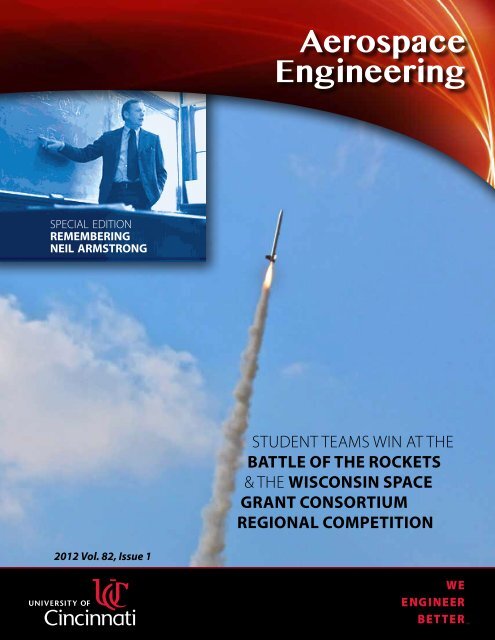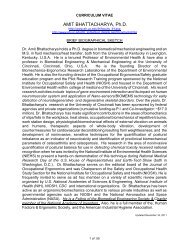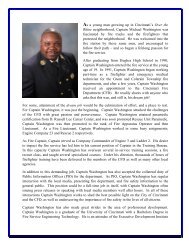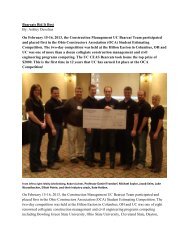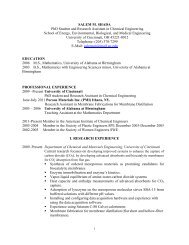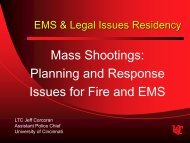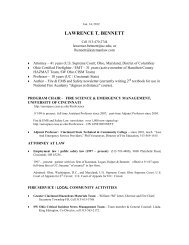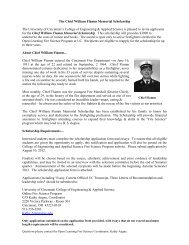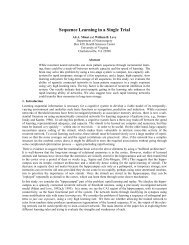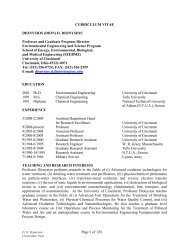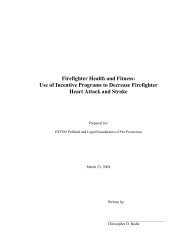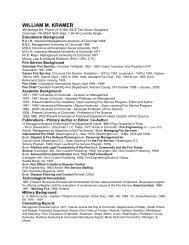School of Aerospace Engineering - University of Cincinnati
School of Aerospace Engineering - University of Cincinnati
School of Aerospace Engineering - University of Cincinnati
You also want an ePaper? Increase the reach of your titles
YUMPU automatically turns print PDFs into web optimized ePapers that Google loves.
special edition<br />
remembering<br />
neil armstrong<br />
2012 Vol. 82, Issue 1<br />
®<br />
<strong>Aerospace</strong><br />
<strong>Engineering</strong><br />
Student teamS win at the<br />
Battle <strong>of</strong> the Rockets<br />
& the Wisconsin space<br />
GRant consoRtium<br />
ReGional competition<br />
we<br />
engineer<br />
better tm
<strong>School</strong> <strong>of</strong> <strong>Aerospace</strong> Systems<br />
Department News<br />
3 Letter from the <strong>School</strong> Director<br />
4 Welcome New Faculty<br />
4 Brenda Smith retires<br />
5 Francesco Simonetti establishes <strong>Cincinnati</strong> NDE, Ltd.<br />
5 Dr. Ephraim Gutmark honored as Fellow <strong>of</strong> American Physical Society<br />
5 Pr<strong>of</strong>. Jeff Kastner moves to <strong>School</strong> <strong>of</strong> <strong>Engineering</strong> Education<br />
5-9 Neil Armstrong remembered<br />
7 The Pr<strong>of</strong>essor Neil Armstrong Memorial Scholarship Fund established<br />
Student News<br />
10 Victory for <strong>Aerospace</strong> “StratoCats”<br />
11 Seniors triumph at the Battle <strong>of</strong> the Rockets<br />
12 Students attend NASA Future Forum<br />
12 Student Awards<br />
13 UC <strong>Aerospace</strong> <strong>Engineering</strong> Graduate Student Wins Scholarship to Prestigious Multicopter Workshop<br />
13 Student Spotlight<br />
Alumni News<br />
14 Class <strong>of</strong> 1974 remembers Pr<strong>of</strong>essor Armstrong<br />
14 Daniel Goddard named Director <strong>of</strong> AFRL’s new Research Collaboration and Computing Directorate<br />
15 Alumni news<br />
15 1972 Class Composite digitized<br />
Contact Us<br />
<strong>University</strong> <strong>of</strong> <strong>Cincinnati</strong><br />
College <strong>of</strong> <strong>Engineering</strong> and Applied Science<br />
<strong>School</strong> <strong>of</strong> <strong>Aerospace</strong> Systems<br />
P.O. Box 210070<br />
<strong>Cincinnati</strong>, OH 45221-0070<br />
513-556-3548<br />
aerospace.ceas.uc.edu<br />
On the Cover<br />
The <strong>University</strong> <strong>of</strong> <strong>Cincinnati</strong>’s entry “Prometheus”<br />
takes first place at the Wisconsin Space Grant<br />
Consortium Rocket Competition<br />
Neil Armstrong in the Classroom<br />
(photo courtesy/UC Photographic Services)<br />
College <strong>of</strong> engineering & Applied Science
Letter from the <strong>School</strong> Director<br />
It is my pleasure to share the news <strong>of</strong> our <strong>Aerospace</strong> <strong>Engineering</strong> undergraduate program<br />
receiving reaccreditation from the <strong>Engineering</strong> Accreditation Commission (EAC) <strong>of</strong> ABET.<br />
That is a testament to our faculty and staff ’s continued efforts and dedication to excellence.<br />
We would like to thank our alumni William Koop, BS 1983, and Donald Dlesk, BS 2005,<br />
Mrs. Anne Isburgh <strong>of</strong> GE Aviation who represented our industrial partners, and Dr.<br />
Richard Rivir <strong>of</strong> AFRL who represented our Advisory Board, for meeting with the visiting<br />
team.<br />
We are especially proud <strong>of</strong> our Senior Space Design team that won the championship<br />
at the 2012 Battle <strong>of</strong> the Rockets Competition sponsored by AIAA and Praxis Inc. Pr<strong>of</strong>essor<br />
Grant Schaffner, the team adviser, assisted another four-student team to earn first place<br />
honors at the Great Mid-West Regional Rocket Competition.<br />
This fall we welcomed our most academically talented freshman class with an average<br />
overall ACT score <strong>of</strong> 29 and ACT math score <strong>of</strong> 30. These scores rank in the top 10% <strong>of</strong> all<br />
graduates nationally. It will be the first group to complete all their undergraduate education<br />
under the semester system that UC implemented this<br />
<strong>Aerospace</strong><br />
engineering<br />
undergraduate<br />
program is<br />
reaccredited by<br />
ABET.<br />
<strong>School</strong> <strong>of</strong> <strong>Aerospace</strong> Systems<br />
Advisory Board (Spring 2012)<br />
Front row, L-R:<br />
Dr. Carol Russo, NASA Ames<br />
Associate, Dr. Christopher<br />
Lorence, GE Aviation; Dr. Tom<br />
Wakeman, Belcan Corporation;<br />
Dr. Mike Heil, Ohio <strong>Aerospace</strong><br />
Institute;<br />
Center row:<br />
Dr. Joe Shang, Wright State<br />
<strong>University</strong>; Dr. D.R. Reddy,<br />
NASA Glen RC; Michael Rudy,<br />
Teledyne Engines; Dr. Ronnie<br />
Miller, PAC/MISTRAS;<br />
Back row:<br />
Dr. Richard Rivir, AFRL/WPAFB;<br />
Lew Soloway, NASA JPL;<br />
Dick Johnson, D3 Technologies;<br />
Dr. Jack Benek, AFRL/WPAFB;<br />
Dr. Eric Baumgartner, Ohio<br />
Northern <strong>University</strong><br />
academic year.<br />
Last spring Lew Soloway, BS 1971, and Kobie Boykins <strong>of</strong> NASA Jet Propulsion Lab visited<br />
the UC campus, gave seminars, recruited co-op students, and interacted with Pr<strong>of</strong>. Schaffner’s<br />
Space Design Class. Our co-op students have performed so well that UC is now identified as one<br />
<strong>of</strong> their top recruiting choices.<br />
Pr<strong>of</strong>essor Bruce Walker received the College’s 2012 Master Educator award and was<br />
promoted to full pr<strong>of</strong>essor. Drs. Mark Turner and Kelly Cohen became tenured as associate<br />
pr<strong>of</strong>essors in 2012. Pr<strong>of</strong>. Cohen led a team <strong>of</strong> UC students who demonstrated the use <strong>of</strong> UAVs in<br />
fighting forest fires in West Virginia. Their experiences were filmed and the team appeared with<br />
the fire chief on a Discovery Channel broadcast.<br />
We recently learned the identity <strong>of</strong> the “Phantom <strong>of</strong> Baldwin” who mysteriously posted a class <strong>of</strong> 1972 composite photo<br />
in Baldwin Hall. Jim Guckian painstakingly built the composite from classmate photos in his “<strong>Cincinnati</strong>an” yearbook, Bearcat<br />
pictures and the names from the commencement program. Thanks to Jim we now have a framed composite <strong>of</strong> his class.<br />
Finally we were all saddened by the loss <strong>of</strong> our former colleague Neil Armstrong. During his eight years (1971-1979) as<br />
a pr<strong>of</strong>essor <strong>of</strong> <strong>Aerospace</strong> <strong>Engineering</strong> at the <strong>University</strong> <strong>of</strong> <strong>Cincinnati</strong> Neil made a lasting impact on the lives <strong>of</strong> his associates,<br />
students and others through his research. His former students John Livingston, BS 1973, Ralph Spitzen, BS 1974, Mark Stear,<br />
BS 1978, and Ken Kroll, BS 1979, shared memories with us at the student-planned August 27 memorial. Thanks to written<br />
communications from several other alumni, which are included in this newsletter, we all can have a glimpse <strong>of</strong> their unique<br />
experiences as his students. Please do not hesitate to drop me an e-mail to add your experiences to Neil’s remembrance Web<br />
page.
d e p a r t m e n t n e W s<br />
this Fall 2012 semester<br />
dr. Jon Friedl joined the<br />
<strong>School</strong> <strong>of</strong> <strong>Aerospace</strong> Systems<br />
as an adjunct pr<strong>of</strong>essor.<br />
Friedl is also currently<br />
a full-time employee at<br />
GE Aviation in Evendale,<br />
Ohio, where he develops<br />
ultrasonic and infrared<br />
inspections for new materials<br />
and hardware on critical jet<br />
engine components using<br />
nondestructive evaluation<br />
(NDE) techniques. Previously, he was the military NDE<br />
coordinator within the core engineering NDE Group<br />
at Pratt & Whitney in East Hartford, Conn., while also<br />
supporting NDE inspection developments in critical jet<br />
engine components.<br />
Last year, Pr<strong>of</strong>essor Friedl was an adjunct lecturer<br />
in the industrial engineering graduate program at the<br />
<strong>University</strong> <strong>of</strong> New Haven in New Haven, Conn., teaching<br />
courses in Decision Analysis and System Simulation. He<br />
currently advises several graduate students from that<br />
program as they complete their mS course <strong>of</strong> study.<br />
Friedl holds a doctorate in <strong>Engineering</strong> mechanics<br />
(2010) and a master <strong>of</strong> Science in Applied Physics (1999)<br />
from Iowa State <strong>University</strong>, a Bachelor <strong>of</strong> Arts in Physics<br />
(1996) and Bachelor <strong>of</strong> Science in <strong>Engineering</strong> Science<br />
(1996) from the <strong>University</strong> <strong>of</strong> michigan-Flint.<br />
Brenda Smith Retires<br />
welCome neW faculty<br />
4 | <strong>University</strong> <strong>of</strong> <strong>Cincinnati</strong>, College <strong>of</strong> <strong>Engineering</strong> and Applied Science<br />
dr. elad Kivelevitch<br />
was recently hired as<br />
an assistant pr<strong>of</strong>essor<br />
educator in the Dynamics<br />
and Controls Group.<br />
Kivelevitch’s research<br />
focuses on the use<br />
<strong>of</strong> complex adaptive<br />
systems and intelligent<br />
systems to solve large<br />
scale optimization<br />
problems. He recently received his doctorate in<br />
<strong>Aerospace</strong> <strong>Engineering</strong> from UC. During his studies, he<br />
taught courses in Dynamics and Control, for which he<br />
received high student appraisal and an award as the<br />
College <strong>of</strong> <strong>Engineering</strong> and Applied Science’s “Pr<strong>of</strong>essor<br />
<strong>of</strong> the Quarter for Spring 2011.”<br />
Prior to joining the <strong>University</strong> <strong>of</strong> <strong>Cincinnati</strong>,<br />
Kivelevitch worked for nine years as a systems engineer<br />
in the Israeli Air Force and Ness Advanced technologies,<br />
an international high-tech company. His industry<br />
experience includes unmanned systems, command and<br />
control systems, intelligent systems, and data fusion. In<br />
addition, Dr. Kivelevitch was a flight principles instructor<br />
at the Israeli Air Force Academy for two years.<br />
After nine years <strong>of</strong> service to <strong>Aerospace</strong> <strong>Engineering</strong>, and 33 years <strong>of</strong> service to UC, Brenda Smith retired at the end <strong>of</strong><br />
July 2012. Brenda first joined UC in 1979 and came to <strong>Aerospace</strong> Systems after previously serving as an Administrative<br />
Secretary II in the UC College <strong>of</strong> Business.<br />
Visitors to the <strong>Aerospace</strong> <strong>of</strong>fice almost invariably met Brenda first. She handled the vast majority <strong>of</strong> the questions<br />
from students, faculty, visitors, and anyone else who walked in the door. She was also the “voice <strong>of</strong> <strong>Aerospace</strong>,”<br />
answering the phones.<br />
Brenda’s duties as an Administrative Secretary II went far beyond being the gatekeeper in the <strong>of</strong>fice. Brenda handled<br />
essentially all issues involving the graduate students, including processing their appointments to assistantship positions,<br />
scheduling all thesis and dissertation defenses and doctoral qualifying examinations, and requesting and collecting<br />
the students’ annual and quarterly progress reports. She was also the primary conduit for all actions that required the<br />
use <strong>of</strong> the <strong>University</strong>’s student information system (UniverSIS), including ordering, scheduling, and altering classes,<br />
maintaining lists <strong>of</strong> academic records for all undergraduate and graduate aerospace students, and querying the system<br />
for specific information when needed. She also processed all <strong>of</strong> the <strong>School</strong>’s purchase orders. She did all <strong>of</strong> these tasks<br />
competently and with a smile.<br />
All <strong>of</strong> us in the <strong>School</strong> <strong>of</strong> <strong>Aerospace</strong> Systems will miss Brenda’s capable presence, especially those <strong>of</strong> us with<br />
administrative jobs. We wish her well as she focuses on answering questions from her grandchildren instead <strong>of</strong><br />
questions from confused students and faculty.
Dr. Francesco Simonetti,<br />
associate pr<strong>of</strong>essor, has<br />
established <strong>Cincinnati</strong> NDE,<br />
Ltd., an Ohio based company<br />
that will commercialize novel<br />
non-destructive evaluation<br />
(NDE) technology developed<br />
at the <strong>School</strong> <strong>of</strong> <strong>Aerospace</strong><br />
Systems. The company will<br />
specialize in integrated sensing<br />
technology for life-cycle<br />
operation and management<br />
<strong>of</strong> complex engineering<br />
systems, and will meet the<br />
inspection needs <strong>of</strong> a wide<br />
range <strong>of</strong> customers including<br />
the aerospace and oil and<br />
gas industries. Dr. Simonetti<br />
is an Ohio Research Scholar<br />
in the Center for Intelligent<br />
Propulsion and Advanced Life<br />
Management.<br />
the Council <strong>of</strong> the American<br />
Physical Society (APS) at its<br />
September 2012 meeting acted<br />
favorably on the nomination<br />
<strong>of</strong> Dr. ephraim Gutmark for<br />
Fellowship in the Society upon the<br />
recommendation <strong>of</strong> the Division<br />
<strong>of</strong> Fluid Dynamics. Election to<br />
Fellowship in the American Physical<br />
Society is limited to no more than<br />
one half <strong>of</strong> one percent <strong>of</strong> the<br />
membership. Election to APS<br />
Fellowship is recognition by his<br />
peers for outstanding contributions<br />
to physics.<br />
Dr. Jeff Kastner joins the <strong>School</strong> <strong>of</strong> <strong>Engineering</strong> Education<br />
Research Assistant Pr<strong>of</strong>essor Jeff Kastner is joining the College<br />
<strong>of</strong> <strong>Engineering</strong> and Applied Science’s <strong>School</strong> <strong>of</strong> <strong>Engineering</strong><br />
Education as an assistant pr<strong>of</strong>essor educator.<br />
Dr. Kastner’s recent research focused on the use <strong>of</strong> chevrons<br />
and fluidic injection to reduce supersonic jet noise. Supported<br />
by funding from the Office <strong>of</strong> Naval Research, the research was<br />
conducted by Kastner and Pr<strong>of</strong>essor Ephraim Gutmark in UC’s<br />
Widen Tabak<strong>of</strong>f Gas Dynamics and Propuslion Laboratory.<br />
In addition, Pr<strong>of</strong>essor Kastner taught the Propulsion<br />
and Fluids undergraduate lab and a graduate course on<br />
aeroacoustics.<br />
d e p a r t m e n t n e W s<br />
Dr. Ephraim Gutmark honored as<br />
Fellow <strong>of</strong> the American Physical Society<br />
the citation on Gutmark’s Fellowship<br />
Certificate reads as follows:<br />
“For his pioneering contributions to the fundamental flow physics<br />
<strong>of</strong> noise, combustion, and propulsion, and the development <strong>of</strong> flow<br />
control methodologies to achieve quiet aircraft engines, clean, stable<br />
and efficient combustion, and innovative propulsion systems.”<br />
aerospace.ceas.uc.edu | 5
d e p a r t m e n t s p o t l i G h t<br />
Pr<strong>of</strong>essor Neil Armstrong in the classroom at UC<br />
by Gary Slater, Pr<strong>of</strong>eSSor emerituS<br />
On Saturday, August 25, the United States and<br />
the world lost one <strong>of</strong> its greatest heroes. Neil<br />
Armstrong will forever be remembered as the<br />
first man to set foot on the moon on July 20, 1969 — an<br />
engineering triumph <strong>of</strong> the new United States space<br />
program. In the last few days there have been many<br />
eloquent eulogies for Neil, recounting his career and his<br />
pinnacle achievement <strong>of</strong> the first moon landing. I would<br />
like to add my thoughts on the passing <strong>of</strong> an American<br />
icon.<br />
I was one <strong>of</strong> the 500 million people worldwide glued<br />
to a black and white TV in 1969 watching every bit <strong>of</strong> the<br />
Apollo 11 descent to the moon. I think my pulse rate was<br />
higher than Commander Armstrong’s during the descent<br />
and to me the most immortal words were not those<br />
associated with the first step (“One small step for man …”),<br />
but rather the calm, almost routine sounding phrase after<br />
touchdown on the lunar surface “Houston: Tranquility<br />
Base here: The Eagle has landed.” While writing this article<br />
I went back and watched the video <strong>of</strong> the descent and<br />
landing on YouTube and it rekindled those same emotions<br />
I felt when I was watching it live. The landing on the moon<br />
was a remarkable achievement that culminated the work <strong>of</strong><br />
thousands <strong>of</strong> engineers and scientists who were working in<br />
the U.S. space program, and one remarkably talented pilot<br />
astronaut.<br />
After Apollo, Neil Armstrong retired from NASA,<br />
and shortly afterwards in 1971 he joined the <strong>University</strong> <strong>of</strong><br />
<strong>Cincinnati</strong> as a Pr<strong>of</strong>essor <strong>of</strong> <strong>Aerospace</strong> <strong>Engineering</strong>. I came<br />
shortly after in 1972. I knew most <strong>of</strong> the faculty already<br />
Remembering Neil Armstrong<br />
6 | <strong>University</strong> <strong>of</strong> <strong>Cincinnati</strong>, College <strong>of</strong> <strong>Engineering</strong> and Applied Science<br />
(I had received my degree there several years earlier) but<br />
meeting Pr<strong>of</strong>essor Armstrong as a colleague was something<br />
I will never forget. All the stories about his quiet demeanor,<br />
his sense <strong>of</strong> humor, his lack <strong>of</strong> ego, are all true. It is hard to<br />
imagine a more reluctant hero than Neil. He never really<br />
thought <strong>of</strong> himself as a hero — he was asked to do a job<br />
and he did it. Flying the Apollo capsule to the moon was<br />
no different to him than flying the X-15 research aircraft,<br />
or any one <strong>of</strong> the many other aircraft he flew during his<br />
career as a naval <strong>of</strong>ficer and as a NASA test pilot. As a<br />
faculty colleague we discussed aircraft flight dynamics (we<br />
both taught those courses), and for a few lectures <strong>of</strong> mine<br />
he even sat in the back <strong>of</strong> the room taking notes! Talk<br />
about pressure! Mostly we chatted about non-technical<br />
things. Over a beer at the faculty club we could discuss the<br />
soybean crop at his Lebanon, Ohio farm or other equally<br />
unremarkable current events. Remarkably, we never<br />
discussed the Apollo program — I was not going to initiate<br />
that conversation, and he never mentioned that aspect <strong>of</strong><br />
his career.<br />
He left the university quite suddenly in 1979 and for<br />
the most part lived a quiet life away from the limelight, and<br />
I had no personal contact with him after that. In recent<br />
years, however, he quite publicly expressed disappointment<br />
and concern about the direction <strong>of</strong> the space program.<br />
Retiring the Shuttle with no replacement in sight for years<br />
was clearly an issue for him. The nation that was first to the<br />
moon, that later built and flew the Space Shuttle, that built<br />
a massive space station now in orbit, now has to buy a ride<br />
to the station on a Russian rocket.<br />
Neil Armstrong’s final legacy is that <strong>of</strong> a reluctant<br />
hero who was a vital part <strong>of</strong> perhaps the most remarkable<br />
technical achievement in the history <strong>of</strong> mankind. Clearly<br />
NASA could not have chosen a more fitting person to<br />
carry the burden <strong>of</strong> that first Moon step. We will miss him<br />
greatly.
Pr<strong>of</strong>essor Neil Armstrong<br />
My classmates and I speculated that Neil grew up with two dreams.<br />
The first was to be a farmer. The other, to fly, took him on the<br />
journey <strong>of</strong> Apollo 11 atop the shoulders <strong>of</strong> a team <strong>of</strong> 400,000 people and the<br />
aspirations <strong>of</strong> countless others. The historic proportions <strong>of</strong> this voyage were<br />
entered over forty years ago in the timeline <strong>of</strong> the world.<br />
There is great comfort to return to one’s roots after a long and risky<br />
journey and no one deserved this more than Neil. Neil’s purchase <strong>of</strong> a farm in<br />
Southwestern Ohio took him home and opened two new doors for him —<br />
farming and teaching future aerospace engineers how to push the envelope<br />
<strong>of</strong> man and machine.<br />
Neil has been described as a reluctant hero, an iconic figure, and a test<br />
pilot’s test pilot. My classmates and I had the great fortune to see another<br />
side <strong>of</strong> Neil — a great aviator who was comfortable making paper airplanes<br />
in UC’s Armory Fieldhouse and a pr<strong>of</strong>essor who enjoyed having beers with<br />
students after final exams. He showed frustration when his assistant was<br />
forced to interrupt class because a NASA administrator refused to wait for<br />
a call back but he tolerated the antics <strong>of</strong> our class when we got restless or<br />
when a famous Italian actress turned photojournalist converted our Baldwin<br />
Hall classroom into a photo-shoot backdrop. About that photo shoot,the<br />
photojournalist was Gina Lollobrigida, one <strong>of</strong> the most popular European<br />
actresses <strong>of</strong> the 1950s and 1960s. She recently photographed Henry Kissinger<br />
and Fidel Castro and was now in <strong>Cincinnati</strong> to capture images <strong>of</strong> Neil and his<br />
students.<br />
Many have written that Neil had nerves <strong>of</strong> steel. I think he was a man<br />
with an extraordinary ability to adapt and learn both on the fly (no pun<br />
intended) and with incredible speed. Couple that with a sixth sense when it<br />
came to timing in the face <strong>of</strong> escalating risks and you have the right stuff to<br />
be Apollo 11’s commander.<br />
I remember my Control Theory pr<strong>of</strong>essor set up a stability simulation<br />
problem using an analog computer. The goal <strong>of</strong> the simulation was for the<br />
operator pilot to use a joystick and keep a pen centered on a small plotter that<br />
was wired to the computer. Most <strong>of</strong> us could keep the pen centered for a few<br />
seconds, indicating we had the system under control, but then each <strong>of</strong> us lost<br />
control and the pen quickly skewed to an edge <strong>of</strong> the plotter indicating we<br />
crashed. Neil took his turn at the simulator. The pr<strong>of</strong>essor then said that Neil<br />
just set the record for maintaining control the longest with this simulation.<br />
Neil ejected from a flight <strong>of</strong> the Lunar Landing Training Vehicle as the<br />
Flying Bedstead (the LLTV’s nickname) became unstable and spun out <strong>of</strong><br />
control at about 100 feet above the ground. A half-second further delay<br />
in ejecting would have resulted in the parachute not opening in time. Neil<br />
landed safely and walked away suffering only from a bloody tongue. Weber<br />
Aircraft manufactured the ejection system and awarded Neil with the ejection<br />
handle handsomely mounted on a simple plaque. The plaque honored his<br />
entry into the Turtle Club where he joined other aviators who paid the price <strong>of</strong><br />
admission by safely ejecting from their aircraft.<br />
Alongside the Weber Turtle Club plaque in Neil’s Rhodes Hall <strong>of</strong>fice was a<br />
prescription bottle with pills for motion sickness. The pills were not prescribed<br />
by a physician but rather presented to Neil by a Soviet Cosmonaut with best<br />
wishes for a safe journey to the moon and then back home. This was a most<br />
interesting gesture considering the state <strong>of</strong> the Space Race between the<br />
Soviet Union and the United States.<br />
If I had the opportunity to ask Neil to reflect on his accomplishments<br />
he likely would have turned our discussion to the future and said something<br />
like — our teams achieved the dreams <strong>of</strong> generations but what’s really<br />
important is what we do next.<br />
The first man to walk on the moon also liked keeping his feet on the<br />
earth and his eyes to the sky and that’s the Neil Armstrong my classmates<br />
and I knew.<br />
by ralPh SPitzen, aSe ’74, mba ’76<br />
NEIL ARMSTRONG MEMORIAL SCHOLARSHIP<br />
W ith lead gifts from alumni donors, Tom Black (ASE ’77)<br />
and Ralph Spitzen (ASE ’74), and school director, Awatef<br />
Hamed, the Pr<strong>of</strong>essor Neil Armstrong Memorial Scholarship<br />
Fund has been established for the <strong>School</strong> <strong>of</strong> <strong>Aerospace</strong><br />
Systems in honor <strong>of</strong> Pr<strong>of</strong>essor Armstrong’s contributions to the<br />
department, the university, the nation and the world.<br />
According to UC Student Financial Aid, 25% <strong>of</strong> aerospace<br />
engineering students graduate with an average <strong>of</strong> $75,000*<br />
<strong>of</strong> debt. Rising tuition and expenses coupled with<br />
decreasing scholarship dollars have students<br />
borrowing signifcant amounts <strong>of</strong> money to<br />
complete their undergraduate degree.<br />
If you would like to make a contribution<br />
or receive additonal information about the<br />
Armstrong Scholarship please contact the<br />
CEAS Development Office at 513-556-6271<br />
or the <strong>School</strong> <strong>of</strong> <strong>Aerospace</strong> Systems at<br />
513-556-3458.<br />
* Includes Parent PLUS loans<br />
aerospace.ceas.uc.edu | 7
d e p a r t m e n t s p o t l i G h t<br />
Skill and Dedication<br />
by mark Stear, bSaSe, ’78<br />
Pr<strong>of</strong>essor Neil Armstrong had that rare capability to present an aerodynamic concept on the blackboard in its<br />
theoretical form, then put down the chalk and turn to the class and describe a personal experience from his days as<br />
a test pilot to bring the concept to life. Through this process, my classmates and I gained a solid understanding <strong>of</strong><br />
aerodynamics as well as a glimpse into the realities <strong>of</strong> flight-testing. We learned that even though things don’t always go as<br />
planned, the laws <strong>of</strong> physics and aerodynamics always prevail.<br />
Neil demonstrated that reality again during my first year as a performance engineer at Gates Learjet Corporation<br />
(Bombardier <strong>Aerospace</strong> Learjet today). Neil served on the Board <strong>of</strong> Directors at Learjet throughout most <strong>of</strong> the 1970s and<br />
the Board wanted some publicity for its new, high-performance Learjet Model 28. So, in February 1979 Neil set a timeto-climb<br />
record in the first production Learjet 28 from sea level to 15,000 meters (49,213 ft.) in 12 minutes, 26.7 seconds.<br />
I was one <strong>of</strong> two Learjet engineers selected to calculate the optimum climb pr<strong>of</strong>ile used by the crew to set the record, and<br />
was on site with the support crew at First Flight Airport in Kitty Hawk, North Carolina when the mission was flown.<br />
Just prior to boarding the Learjet 28 at Kitty Hawk, Neil approached the other engineer, Dave, and myself to discuss<br />
a last minute unexpected change in the take<strong>of</strong>f pr<strong>of</strong>ile. It seems that air traffic control had cleared the flight through an<br />
unrestricted climb corridor to the Southeast out over the Atlantic Ocean, but the runway orientation and surface winds<br />
at Kitty Hawk necessitated a take<strong>of</strong>f to the Northeast. Neil explained that rather than a straight-out climb as he and his<br />
co-pilot, Pete Reynolds (a Learjet test pilot) had practiced in Wichita the day before, they would have to make a substantial<br />
right turn immediately after take<strong>of</strong>f to establish the proper heading for which the flight had been cleared. Neil was asking<br />
us whether a gradual turn to the right while accelerating, or an immediate turn at low speed before accelerating would<br />
result in the lowest energy usage. Hmmm, Dave and I were scratching our heads and fumbling for our calculators when<br />
Neil suggested that an immediate right turn before accelerating seemed like the best choice to him. We looked at each<br />
other, still dumbfounded by the unexpected change in our carefully calculated mission, and simultaneously agreed, “Yup,<br />
sounds good to us Neil, we think that would be best!” To this day, I’m not sure we ever really knew which type <strong>of</strong> turning<br />
maneuver was best, but who was going to challenge the gut instincts <strong>of</strong> Neil Armstrong on an aircraft performance<br />
question?!<br />
The resulting take<strong>of</strong>f was quite spectacular as<br />
I watched the Learjet from the side <strong>of</strong> the runway<br />
make an abrupt right turn with a steep nose-up<br />
orientation at treetop level (do not try this at home)<br />
while leveling <strong>of</strong>f for the initial acceleration to 250<br />
knots before commencing the record climb. Less<br />
than 12.5 minutes later, a new world record had<br />
been set as the Learjet zoomed through 15,000<br />
meters and the crew turned back toward a planned<br />
landing at Elizabeth City, North Carolina.<br />
At this point, the flight test plan simply called for<br />
a gradual descent at idle power back to Elizabeth<br />
City, some 28 nautical miles from Kitty Hawk. To<br />
keep the plane as light as possible, only enough fuel<br />
to make the climb and return to base, with minimal<br />
reserves was loaded. Neil and Pete had practiced<br />
this mission several times in Wichita and we had<br />
good handle on the fuel required for the mission.<br />
What none <strong>of</strong> us had planned, though, was the<br />
fact that as they turned back toward Elizabeth City<br />
8 | <strong>University</strong> <strong>of</strong> <strong>Cincinnati</strong>, College <strong>of</strong> <strong>Engineering</strong> and Applied Science
they now realized the winds al<strong>of</strong>t were blowing at nearly 100 knots, from the Northwest — direct headwind! What was<br />
planned as a leisurely descent at idle power quickly became an anxious seat-<strong>of</strong>-the-pants exercise in energy management<br />
to minimize fuel flow while maximizing forward ground speed. Fuel flow is lowest at high altitude, but that’s where the<br />
strongest winds were. Neil and Pete were the two best pilots to handle this problem, and Pete later shared the story <strong>of</strong> their<br />
conversation in the cockpit while on a long final approach into Elizabeth City. The conversation reportedly went something<br />
like this: Neil: “How much fuel do we have, Pete?” Pete: “Well, the ‘LEFT’ tank reads 250 pounds, the ‘RIGHT’ tank reads<br />
150 pounds, but if I put the selector on ‘BOTH’ it reads 500 pounds.” Neil: “Keep the selector on ‘BOTH’!”<br />
The flight ended safely at Elizabeth City as planned and we all enjoyed a celebratory dinner that night at the hotel.<br />
The next morning as we gathered around the record setting Learjet Model 28 to prepare for departure, a Learjet mechanic<br />
climbed into the cockpit to start the engines and taxi the plane across the ramp for refueling. As the left jet engine roared<br />
to life and was settling to its idle speed, it had no sooner stabilized than it suddenly flamed out and quietly spooled down.<br />
The engine had quit from fuel starvation. That was it. There was no more fuel in the plane! We then realized just how close<br />
Neil and Pete (and the <strong>of</strong>ficial NAA observer) had come to falling a bit short <strong>of</strong> their goal. Just as Neil’s skillful piloting<br />
had landed him and Buzz Aldrin on the moon in 1969 with less than 30 seconds <strong>of</strong> fuel remaining, the same piloting skill<br />
and keen engineering instincts brought him to a safe landing in a Learjet ten years later with less than 30 seconds <strong>of</strong> fuel<br />
remaining.<br />
After the plane was refueled that morning, I had the privilege <strong>of</strong> riding as a passenger in the same Learjet 28 with<br />
Pr<strong>of</strong>essor Armstrong and Pete Reynolds at the controls, as we took Neil from Elizabeth City back to <strong>Cincinnati</strong> on that<br />
sunny Tuesday morning so he could teach his next class at UC! Though a few minutes late to class, it’s clear that he was as<br />
dedicated to his students as he was to the board <strong>of</strong> directors.<br />
It is rare that a pr<strong>of</strong>essor <strong>of</strong> any subject can draw upon their years <strong>of</strong> real life experience to convey that subject to their<br />
students. UC and my fellow <strong>Aerospace</strong> <strong>Engineering</strong> students <strong>of</strong> the ‘70s had the privilege <strong>of</strong> working and learning from one<br />
<strong>of</strong> the best. He will be missed greatly by all who knew him.<br />
aerospace.ceas.uc.edu | 9
s t u D e n t S p o t l i g h t<br />
Four UC <strong>Aerospace</strong> <strong>Engineering</strong> students are celebrating a<br />
triumphant win as their team “StratoCats” won first place<br />
in the Great Midwestern Regional Space Grant Student<br />
Rocket Competition, held at the Bong Recreational Area in<br />
Wisconsin, April 27-29, 2012. The aerospace competition<br />
is open to university teams from Indiana, Illinois, Iowa,<br />
Kansas, Michigan, Minnesota, Missouri, Ohio and<br />
Wisconsin.<br />
<strong>Engineering</strong> teams competed to design a one-stage,<br />
high-powered rocket that, during its ascent, would transmit<br />
live video from a downward looking camera to a ground<br />
receiver. The rocket was to soar as close to 3000 feet as<br />
possible. The competition included design analysis, an oral<br />
presentation and an assessment <strong>of</strong> data results, scored by<br />
pr<strong>of</strong>essional engineers from both academia and industry.<br />
In order to ensure these parameters were met, the<br />
team took an outside-<strong>of</strong>-the-box approach. “In rocketry, it<br />
is <strong>of</strong>ten presented to build a light rocket with a large engine<br />
that will overshoot your target altitude,” Joseph Honeck, the<br />
team’s president, said. “Often times, engineers are scrambling to get every<br />
ounce <strong>of</strong> weight out <strong>of</strong> space craft. Very rarely are they finding that more<br />
weight needs to be added. We started with a design we knew would be very<br />
close to our weight limit with the largest engine accepted in the competition.”<br />
Since the original rocket design consisted mainly <strong>of</strong> wood internals and<br />
a phenolic body tube that was wrapped in fiberglass, it put the StratoCats<br />
substantially over the weight limit, subsequently sending them back to the<br />
drawing board. “We began re-designing all wooden parts; avionics bay,<br />
motor mount, bulk heads, and other small components,” Honeck explains.<br />
This new design resulted in a shedding <strong>of</strong> close to five pounds from the<br />
original 27-pound model.<br />
In order to alleviate concern over failing parts, the StratoCats designed<br />
a removable motor mount<br />
along with removable fins<br />
so that if anything broke<br />
during the rocket’s ascent or<br />
descent, they could easily<br />
swap it with replacements.<br />
“Everything, with the<br />
exception <strong>of</strong> the mounting<br />
bulk heads, down to the<br />
vinyl wrap on the outside<br />
<strong>of</strong> the tube, was able to be<br />
removed and replaced in<br />
between launches,” Honeck<br />
said.<br />
The team had a late<br />
start on the competition<br />
and just as they finished the<br />
rocket, they were plagued<br />
with two weeks <strong>of</strong> windy,<br />
10 | <strong>University</strong> <strong>of</strong> <strong>Cincinnati</strong>, College <strong>of</strong> <strong>Engineering</strong> and Applied Science<br />
rainy weather. “We were unable to do any test flights and therefore we had<br />
little control over what was going to happen, and on top <strong>of</strong> that, it was windy<br />
and rainy at the competition,” Honeck reflects.<br />
The StratoCats ran numerous simulations in order to dial in when they<br />
wanted to deploy each parachute, how much the rain and wind would affect<br />
the rocket’s altitude and whether or not weight would need to be added or<br />
subtracted from the rocket.<br />
Honeck remembers the day <strong>of</strong> the <strong>of</strong>ficial rocket launch at the<br />
competition as even more daunting. “We watched five rockets before us<br />
fail catastrophically and one drift miles away from the launch sight. Even<br />
though this was horrifying, we were sure we had it right.” And they did. The<br />
StratoCats were the first successful launch <strong>of</strong> the day.<br />
Competitions like this one <strong>of</strong>ten inspire creativity among students,<br />
allowing them to expand their knowledge outside <strong>of</strong> homework and tests.<br />
These collaborations get them excited about bringing that knowledge to<br />
life through teamwork and practical experience. “Often times, without<br />
realizing, we present ourselves with much more challenging problems<br />
than those brought forth in class and are able to solve them more readily<br />
through teamwork and the atmosphere brought by competition and practical<br />
experience,” Honeck said. “This ultimately gives UC students the competitive<br />
edge needed in industry today by gaining critical teamwork and engineering<br />
problem-solving skills that cannot be taught in the classroom.”<br />
Grant Schaffner, adviser for the UC Rocketry Club, agrees. “The process<br />
teaches them valuable project management and systems engineering<br />
skills in a practical, ‘real world’, environment. They also develop strong<br />
communication skills,” Schaffner said. “Our students do very well in<br />
these competitions, which is a testament to the strength <strong>of</strong> the academic<br />
preparation and co-op experiences provided by the UC <strong>Aerospace</strong> <strong>Engineering</strong><br />
program.”<br />
Schaffner plans to have the team participate in the NASA <strong>University</strong><br />
Student Launch Initiative (NASA USLI) starting in the fall.
Seniors triumph at the Battle <strong>of</strong> the Rockets<br />
Two teams <strong>of</strong> UC <strong>Aerospace</strong> <strong>Engineering</strong> students compete at the 2012 Battle <strong>of</strong> the Rockets in Culpeper, Virginia.<br />
As part <strong>of</strong> their senior design project, 20 aerospace engineering seniors competed in the American Institute <strong>of</strong> Aeronautics<br />
and Astronautics (AIAA) and Praxis, Inc. “Battle <strong>of</strong> the Rockets Competition” held on March 31. The event is an aerospace<br />
competition open to universities and high schools, run by a local rocketry society in Culpeper, Virginia. The UC seniors<br />
were divided into two teams, with one emerging as the first place champion!<br />
Two teams composed <strong>of</strong> 10 aerospace engineering students each, the “Rocket Underground” and the “Chewbaccateers,”<br />
participated in the Planetary Rover Event. In this event student teams are required to design and create a Mars rover, an<br />
automated motor vehicle, to be housed in and launched from a rocket. Very few teams participate in this category, likely<br />
because <strong>of</strong> the category’s high complexity.<br />
During the competition, teams launch their rockets<br />
(with rovers inside) to a minimum height <strong>of</strong> 1,000 feet in<br />
altitude. Once launched, the rocket must come apart and<br />
deploy its rover. The rover must then be safely transported<br />
to the ground via parachute. Once on the ground, the rover<br />
must operate autonomously to move a designated distance<br />
and make required turns, all while dropping markers.<br />
Each team independently chose their own path to<br />
designing their ideal rocket and rover, creating two very<br />
impressive systems. The design process is a complex<br />
task. Student teams build their aero-system from scratch,<br />
programming all movements and applying sensors to meet<br />
all competition requirements. With their successful launch<br />
and landing, the “Rocket Underground” won first place and<br />
became the Planetary Rover Event champions!<br />
In the process <strong>of</strong> preparing for the competition, students<br />
were exposed to both project management and systems<br />
engineering. Pr<strong>of</strong>essor Grant Schaffner, was the students’<br />
adviser throughout the class and competition. “The<br />
competition allowed for a practical application <strong>of</strong> the skills<br />
rather than in a classroom setting,” describes Schaffner.<br />
Schaffner states, “Both teams did extremely well, and I am very proud <strong>of</strong> them for winning the competition.” He plans to<br />
bring another set <strong>of</strong> UC students next year to defend their title. Schaffner is hopeful that CEAS students will continue to<br />
triumph at competitions to come.<br />
Alex Walker holds the Chewbaccateers team’s rover while other team members in the background<br />
prepare to integrate the rover into the rocket.<br />
aerospace.ceas.uc.edu | 11
s t u D e n t S p o t l i g h t<br />
Aersospace students attend NASA Future Forum<br />
NASA Administrator Charles Bolden, Deputy Administrator Lori Garver and Sen. John Glenn discussed NASA’s past,<br />
present and future during the NASA Future Forum at Ohio State <strong>University</strong> in Columbus on Feb. 20-21. the forum<br />
coincided with the 50th anniversary <strong>of</strong> Glenn’s historic Friendship 7 space flight.<br />
Glenn joined space agency <strong>of</strong>ficials, astronauts, technologists, scientists, engineers and students to discuss the<br />
role NASA will play in advancing innovation, technology, science, engineering, education and the economy that<br />
benefits Ohio and the nation.<br />
the program featured panel discussions on the importance <strong>of</strong> education to our nation’s future in space, the<br />
benefit <strong>of</strong> commercialized space technology to our economy and lives here on Earth, and the shifting roles for the<br />
public, commercial and international communities in space.<br />
Student Nathan Wukie, left, discusses his research with NASA Administrator Charles Bolden Student Robert Charvat pictured with Sen. John Glenn<br />
Student Awards<br />
afRl/DaGsi award ($25,000 + tuition)<br />
Steven Etheridge<br />
Chelsea Sabo<br />
Nicholas Ernest<br />
choose ohio first scholars award ($4,500 per year)<br />
Patrick Rachow<br />
Alicia Zwiebel<br />
nsf/summer Reu award ($4,300)<br />
Devon Riddle<br />
Owen Macmann<br />
nsf/ay award ($3,000)<br />
Sophia Mitchell<br />
Brandon Cook<br />
nsf/GsRp award ($30,000 + tuition)<br />
Michael Knadler<br />
thomas Byer /alumni scholarships (average award $2,000 )<br />
Brandon Cook, Andrea Gillis, Daniel Harriman,<br />
Stephen Higgins, David Hopperton, Paul Miller,<br />
Christine Weaver, Richard Zelinski Jr.<br />
12 | <strong>University</strong> <strong>of</strong> <strong>Cincinnati</strong>, College <strong>of</strong> <strong>Engineering</strong> and Applied Science<br />
nasa space Grant awards<br />
Undergraduate Scholars<br />
Senior awards ($4,000 total– $3,500 NASA + $500 UC)<br />
Tyler Vick (ASE, continuing)<br />
Alex Walker (ASE, continuing)<br />
Junior Awards ($3,000 total – $2,500 NASA + $500 UC)<br />
Sophia Mitchell (ASE, new)<br />
Owen MacMann (ASE, new)<br />
Nicholas Schwartz (ASE, new)<br />
Daniel Harriman (ASE, new)<br />
PhD Fellowships (three year award: per year $20,000 total –<br />
$15,000 NASA + $5000 UC + tuition)<br />
Adam Gerlach (ASE, 3rd year, continuing)<br />
Robert Knapke (ASE, 2nd year, new)<br />
Nicholas Heeb (ASE, new)<br />
MS Fellowships (1.5 year award: per calendar year: $16,000 total –<br />
$13,000 NASA + $3,000 UC + tuition)<br />
Krista Kirievich (ASE, new)<br />
(all pending final NASA approval)
<strong>Aerospace</strong> <strong>Engineering</strong> graduate student<br />
wins scholarship to prestigious<br />
multicopter workshop<br />
UC <strong>Aerospace</strong> <strong>Engineering</strong> graduate student and PhD candidate, Chelsea<br />
Sabo, was chosen to participate in the International Graduate <strong>School</strong><br />
on Mobile Communications at the Ilmenau <strong>University</strong> <strong>of</strong> Technology in<br />
Ilmenau, Germany. Out <strong>of</strong> 200 applicants from all over the world, Sabo was<br />
one <strong>of</strong> only eight to be selected for the workshop. This acceptance is a once<br />
in a lifetime opportunity and a UC first!<br />
Sabo’s research focuses on the distribution <strong>of</strong> multiple Unmanned<br />
Aerial Vehicles (UAVs) and reducing effects communication constraints have<br />
on them. Communication constraints include restriction by line-<strong>of</strong>-sight,<br />
maximum communication ranges or a need for uninterrupted transmission.<br />
These restrictions present a practical challenge to those who use UAV’s and<br />
usually result from the UAV’s heavyweight hardware systems.<br />
Sabo explains the growing need for her research, “The<br />
circumstances where UAVs are increasingly being used in supplying<br />
surveillance include search and rescue missions, forest fire monitoring,<br />
traffic surveillance, agricultural applications, pipe-line monitoring, border<br />
patrol, and military applications. Because <strong>of</strong> the numerous applications <strong>of</strong><br />
UAVs, their presence will continue to grow. Effective and safe autonomous<br />
algorithms are necessary to ensure the continued integration <strong>of</strong> UAVs<br />
into shared air space. Therefore, as we move toward a world where much<br />
<strong>of</strong> our surveillance is being performed by small, lightweight, mobile<br />
sensors, limited communication ranges will always be a concern. However,<br />
this restriction makes the allocation <strong>of</strong> individual UAVs for cooperative<br />
Chelsea Sabo, extreme right, at the International Multicopter Girls Camp 2012<br />
strategies a very difficult problem and has been the focus <strong>of</strong> my dissertation<br />
work.”<br />
Sabo enthusiastically prepares for a future in research, focusing on<br />
developing systems. As an Associate Member <strong>of</strong> the Intelligent Systems<br />
Technical Committee <strong>of</strong> the American Institute <strong>of</strong> Aeronautics and<br />
Astronautics, she has discovered an interest and plans to pursue work in<br />
intelligent systems. Nobody could be more proud <strong>of</strong> Sabo than her adviser,<br />
Associate Pr<strong>of</strong>essor Kelly Cohen. He reflects, “I firmly believe that in the past<br />
five years, I have known no other graduate student who has achieved as<br />
much in our program at the <strong>University</strong> <strong>of</strong> <strong>Cincinnati</strong> as Ms. Sabo.”<br />
two outstanding aerospace engineering students were awarded “Best Presentation” designations at the 7th Annual<br />
Dayton <strong>Engineering</strong> Sciences Symposium. the American Society <strong>of</strong> mechanical Engineers (ASmE) Dayton Section<br />
recognized cody lafountain, mS student, and sophia mitchell (Class <strong>of</strong> 2016), at the AIAA/ASmE Awards Banquet<br />
held on may 24, 2012, at the <strong>University</strong> <strong>of</strong> Dayton.<br />
Downing Naber<br />
During the recent UC-Delaware State<br />
football game Brandon cook, (Class<br />
<strong>of</strong> 2015), an <strong>Aerospace</strong> ACCEND<br />
student with a 3.98 GPA, was honored<br />
as the CEAS “Engineer <strong>of</strong> the month”<br />
for September.<br />
michael Downing and logan a. naber, aerospace engineering<br />
students, received the 2012 <strong>Engineering</strong> Pr<strong>of</strong>essional Practice<br />
Achievement Recognition Awards. their dedication and hard<br />
work is the essence <strong>of</strong> what continues to make UC/ASE’s co-op<br />
program an award winner!<br />
aerospace.ceas.uc.edu | 13
a l u m n i S p o t l i g h t<br />
Memories <strong>of</strong> Neil Armstrong from the Class <strong>of</strong> 74<br />
The BSAE class <strong>of</strong> ’74 was the first class that Neil taught at UC. Below are some comments from their reunion in 2000.<br />
Most Useful Class<br />
“Aircraft Design. In my last several co-op quarters and my<br />
first year and a half as an engineer, I worked on developing<br />
a preliminary design code for fighter aircraft design. I later<br />
worked on Winging-ground (WIG) aircraft design, before<br />
leaving DTNSRDC. At Wright Patt my job was primarily<br />
tactical systems focused from a systems perspective. At<br />
GEAE, I first worked ATOVL and then HSCT as a project<br />
manager, always from a systems perspective.” — Fred Krause<br />
“Aircraft Flight Testing with Neil Armstrong was the<br />
most useful class. On March 25, 1974, Italian actress Gina<br />
Lollobrigida came to class to photograph Neil and his<br />
students. Gina was also a successful photographer and was<br />
shooting some <strong>of</strong> the world’s greatest people for women’s<br />
magazines. Having already photographed Fidel Castro and<br />
Henry Kissinger, she turned to Armstrong. The classroom<br />
photograph with John Aicholtz, Rick Marickovich, Don<br />
Klick, and me appeared in the August 1974 Ladies Home<br />
Journal.” ?? — Tim Kinne<br />
Memories<br />
“The first day <strong>of</strong> class for Neil Armstrong. How after class he<br />
pushed us out the door, slammed the door shut to evade the<br />
army <strong>of</strong> reporters waiting in the hallway.” — Dave Burrus<br />
“I told my fourth grade nephew that Neil Armstrong was one<br />
<strong>of</strong> my college pr<strong>of</strong>essors. When he told his teacher, she told<br />
him to ‘quit telling lies.’ She believed him after I wrote a letter.”<br />
— Jim Kocher<br />
“I remember sitting in our aircraft performance class with<br />
Andy Lee and just getting into one <strong>of</strong> those moods when I<br />
just couldn’t stop laughing. Andy couldn’t stop either. I have<br />
to idea what started it, but Armstrong threw us out.”<br />
— Fred Krause<br />
Daniel Goddard named Director <strong>of</strong> AFRL’s new<br />
Research Collaboration and Computing Directorate<br />
The Air Force Research Laboratory (AFRL) is reconfiguring the Computational Science and <strong>Engineering</strong> Office, AFRL/RC, to merge corporate strategy, policy and operations<br />
for both business and scientific computing systems as well as corporate information <strong>of</strong>fice functions. The new <strong>of</strong>fice will be named Research Collaboration and Computing<br />
Directorate.<br />
The first director <strong>of</strong> the Research Collaboration and Computing Directorate is Daniel G. Goddard. Goddard is currently the acting technical director <strong>of</strong> the <strong>Engineering</strong> and<br />
Technical Management Directorate at HQ Air Force Materiel Command (AFMC) where he is responsible for technical performance, reliability, quality assurance and configuration<br />
definition <strong>of</strong> all AFMC product lines.<br />
He has a wide range <strong>of</strong> additional engineering experiences including chief, Systems <strong>Engineering</strong> Division in AFMC/EN; chief, Warfighter Interface Division, Human<br />
Effectiveness Directorate in the 711th HPW; deputy division chief, Structures Division in Air Vehicles Directorate and technical adviser, Global Mobility System Program Office.<br />
Goddard received his BS in <strong>Aerospace</strong> <strong>Engineering</strong> in 1983 from the <strong>University</strong> <strong>of</strong> <strong>Cincinnati</strong>, and earned an MS in Aeronautical <strong>Engineering</strong> from AFIT as well as an MS from<br />
the National Technological <strong>University</strong> in Management <strong>of</strong> Technology. He is also a graduate <strong>of</strong> Air War College.<br />
14 | <strong>University</strong> <strong>of</strong> <strong>Cincinnati</strong>, College <strong>of</strong> <strong>Engineering</strong> and Applied Science<br />
‘<br />
More memories from Tim Kinne, — “One time during the end<br />
<strong>of</strong> the quarter <strong>of</strong> the first class, Aircraft Performance, that Neil<br />
taught at UC, Dave Burros said to Neil as he walked into the<br />
room, we have been kind all quarter, today you are going to<br />
tell stories. Now Neil had no idea that this was coming. So he<br />
told us a couple <strong>of</strong> very interesting stories, however, he was so<br />
brilliant that he worked his lecture around the stories.”<br />
“I worked with him on an independent study class with Dr.<br />
Kroll. He was extremely helpful; he genuinely cared about<br />
my project and provided great insight into the problem I was<br />
working on.”<br />
“Every nice thing that is said about Neil in the press is true.<br />
He was very kind and gentle, he was brilliant, he was business<br />
like, he had a dry sense <strong>of</strong> humor, and he always wanted to<br />
help others.”
In Memoriam<br />
Ross Olander, AE ‘65, died July 18 after a 19 month battle with pancreatic cancer. Olander was<br />
a senior partner in Foster Miller, an engineering design firm spun <strong>of</strong>f from MIT 40 years ago. He<br />
is survived by his wife, Julie, two children and two grandchildren.<br />
Bruce Gahn, AE ‘72, MSAE ‘77 died May 29. Gahn was diagnosed with a Glioblastoma<br />
multiforme malignant brain tumor in August 2010. He received care from doctors at the<br />
Mayfield Clinic neurosurgical practice affiliated with the Brain Tumor Center within the UC<br />
Neuroscience Institute.<br />
After graduation in 1972 Bruce joined GE Aviation in <strong>Cincinnati</strong> where he worked until<br />
his retirement in December 2009. As a manager and technical expert on aircraft engine<br />
performance he was involved in virtually every engine program at GE and most <strong>of</strong> the<br />
commercial airplane programs for more than three decades. He developed and mentored many<br />
engineers where his combination <strong>of</strong> technical excellence, inquisitiveness, and personality made<br />
him a great person to learn from and work with. One <strong>of</strong> his favorite leisure activities was hiking<br />
and camping in the Great Smoky Mountains.<br />
Bruce is survived by his wife <strong>of</strong> almost 39 years Shelley; his daughter Gina and husband Jeff,<br />
and their sons Ben and Kyle; and his son Jeffrey and wife Andrea.<br />
1972 class composite digitized!<br />
Special thanks to Jim Guckian, AE 1972, for recreating the class composite above. After many years<br />
<strong>of</strong> absence from the display case in Baldwin Hall it is once again prominently displayed.<br />
Unfortunately other class composites were lost in the 1990’s when they were taken down to be reframed.<br />
Please contact us if you can help locate composite photos for the classes <strong>of</strong> 1970 and 1971.<br />
a l u m n i n e w S<br />
Donald W. Dlesk Jr., AE ‘06, has a nine-year<br />
history as a Belcan employee where he began<br />
his career as a co-op and has reached the level <strong>of</strong><br />
lead structural engineer for finite element analysis<br />
<strong>of</strong> jet engine composite components. Dlesk was<br />
recently married to Mirna Assaf in July <strong>of</strong> this year<br />
after meeting her in Beirut, Lebanon where he<br />
was the best man for another UC aerospace grad,<br />
Joseph Stern.<br />
Ron Hess, AE ‘64, is currently a pr<strong>of</strong>essor at the<br />
<strong>University</strong> <strong>of</strong> California- Davis and was honored by<br />
being selected as AIAA Fellow.<br />
AIAA Fellow Edward M. “Ed” Kraft, AE ‘68,<br />
chief technologist, Arnold <strong>Engineering</strong><br />
Development Center, Arnold Air Force Base,<br />
Tenn., delivered the keynote address, “Systemic<br />
Challenges to Defense Acquisitions,” at the<br />
annual AIAA Public Policy Luncheon held<br />
January 9, 2012 at the Gaylord Opryland Resort<br />
and Convention Center, Nashville, Tenn.<br />
During his remarks, Kraft addressed a<br />
systems view <strong>of</strong> defense acquisition, which<br />
could allow a better understanding <strong>of</strong> the<br />
continually increasing challenges to producing<br />
timely and cost-effective output from the<br />
acquisition process.<br />
John Louis, AE ‘05, <strong>of</strong> Flight Sciences <strong>Engineering</strong><br />
at Gulfstream <strong>Aerospace</strong> Corporation, reports<br />
that all current and former UC co-ops/graduates<br />
working at Gulfstream played a role in the<br />
certification programs for the G650 and G280<br />
aircraft. Both aircraft were recently certified, and<br />
will go into service in the near future.<br />
Alex Sullivan, AE ‘05, has moved to the G650<br />
program at Gulfstream <strong>Aerospace</strong> where he<br />
assumed leadership <strong>of</strong> Electrical Component<br />
Installations and Water & Waste. Alex and his wife<br />
had their first child, Parker Joseph Sullivan, in the<br />
summer <strong>of</strong> 2011.<br />
aerospace.ceas.uc.edu | 15
<strong>University</strong> <strong>of</strong> <strong>Cincinnati</strong><br />
College <strong>of</strong> <strong>Engineering</strong> and Applied Science<br />
<strong>School</strong> <strong>of</strong> <strong>Aerospace</strong> Systems<br />
P.O. Box 210070<br />
<strong>Cincinnati</strong>, OH 45221-0070


